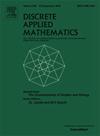A decomposition structure of resonance graphs that are daisy cubes
IF 1
3区 数学
Q3 MATHEMATICS, APPLIED
引用次数: 0
Abstract
It has recently been shown in Brezovnik et al. (2025) that the resonance graph of a plane elementary bipartite graph with more than two vertices is a daisy cube if and only if is peripherally 2-colorable. Let be a peripherally 2-colorable graph and be its resonance graph. We provide a decomposition structure of with respect to an arbitrary finite face of together with a proper labeling for the vertex set of . An algorithm is obtained to generate a binary coding for all perfect matchings of which induces an isometric embedding of as a daisy cube into an -dimensional hypercube, where is the isometric dimension of . We conclude the paper with an easy conversion between two binary codings for all perfect matchings of which induce distinct structures on : one as a daisy cube and the other as a finite distributive lattice, respectively.
菊花立方体共振图的分解结构
最近,Brezovnik et al.(2025)证明了具有两个以上顶点的平面初等二部图G的共振图是一个daisy立方体当且仅当G是外围2色的。设G是一个外围2色图,R(G)是它的共振图。我们给出了R(G)关于G的任意有限面的分解结构,并给出了R(G)的顶点集的适当标记。得到了一种对G的所有完美匹配生成二进制编码的算法,该算法将作为雏菊立方体的R(G)等距嵌入到n维超立方体中,其中n为R(G)的等距维数。对于G的所有完美匹配,在R(G)上产生不同的结构,一个是菊花立方体,另一个是有限分配格,我们用两种二进制编码之间的简单转换来总结本文。
本文章由计算机程序翻译,如有差异,请以英文原文为准。
求助全文
约1分钟内获得全文
求助全文
来源期刊

Discrete Applied Mathematics
数学-应用数学
CiteScore
2.30
自引率
9.10%
发文量
422
审稿时长
4.5 months
期刊介绍:
The aim of Discrete Applied Mathematics is to bring together research papers in different areas of algorithmic and applicable discrete mathematics as well as applications of combinatorial mathematics to informatics and various areas of science and technology. Contributions presented to the journal can be research papers, short notes, surveys, and possibly research problems. The "Communications" section will be devoted to the fastest possible publication of recent research results that are checked and recommended for publication by a member of the Editorial Board. The journal will also publish a limited number of book announcements as well as proceedings of conferences. These proceedings will be fully refereed and adhere to the normal standards of the journal.
Potential authors are advised to view the journal and the open calls-for-papers of special issues before submitting their manuscripts. Only high-quality, original work that is within the scope of the journal or the targeted special issue will be considered.
 求助内容:
求助内容: 应助结果提醒方式:
应助结果提醒方式:


